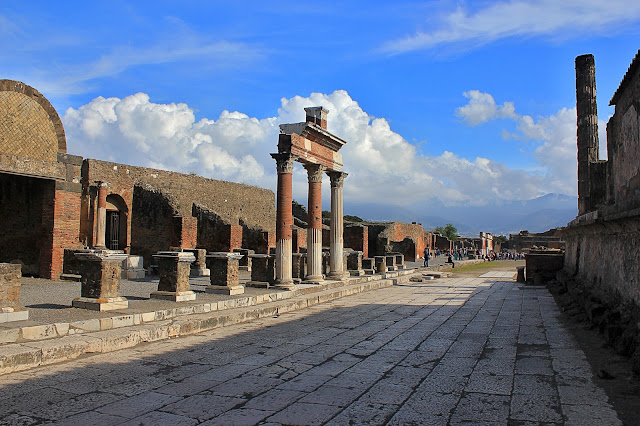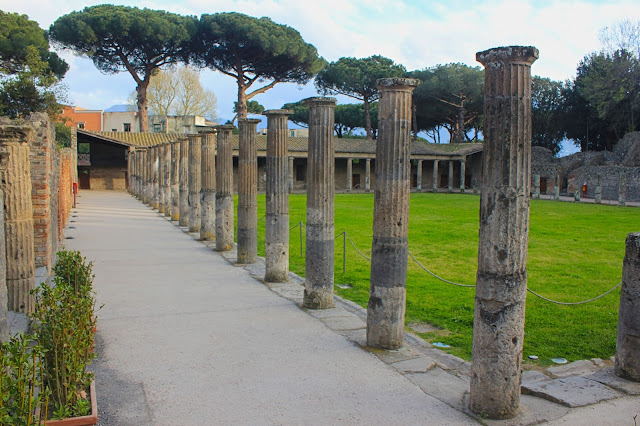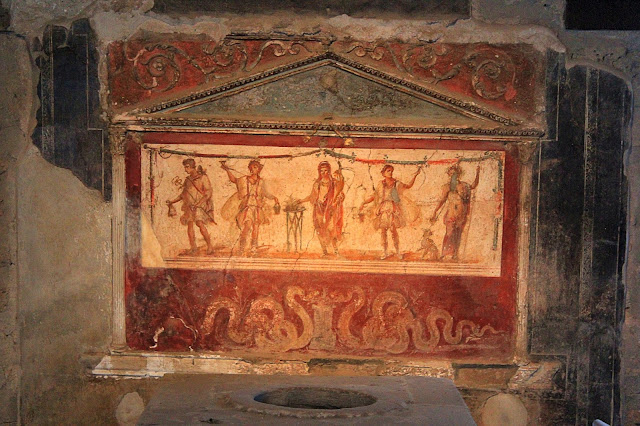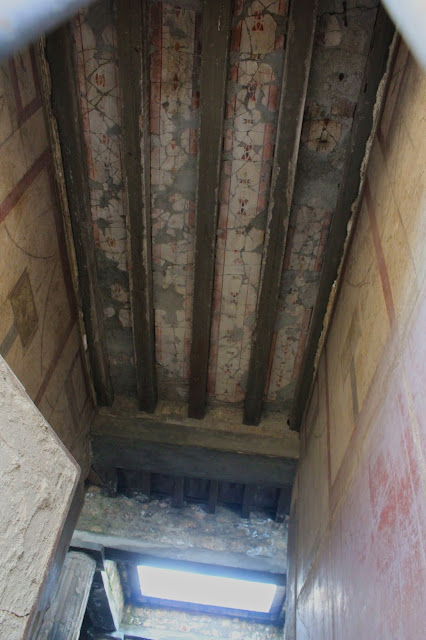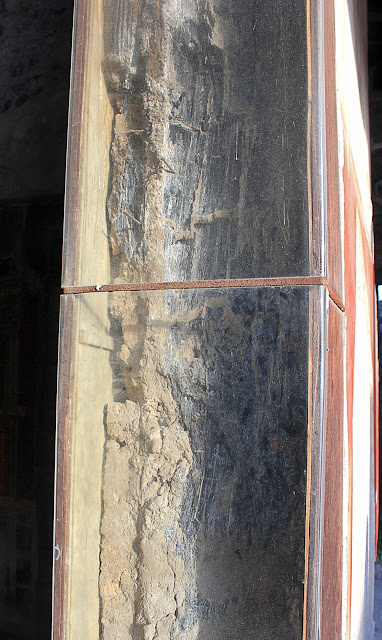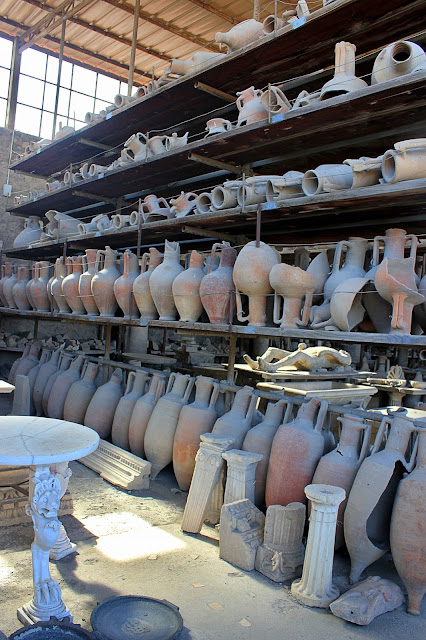Pompeii
Bucketlist Trip: Pompeii
I didn't expect it to, but visiting Pompeii affected me deeply. I don't look at ancient calamities the same way any more.
Why Visit Pompeii?
World-renowned Pompeii is the birthplace of Archaeology. Before Giuseppe Fiorelli invented the systematic excavation and recording system here, there was only looting. Pompeii gives us an unparalleled snapshot of 1st-Century Roman life, preserved for over 1700 years under several meters of volcanic ash that killed over 16,000 people.But it's more than just ruins, facts, and figures. In Pompeii, you can see the ruts made by centuries of carts carrying life's necessities; walk through family houses and see their portraits; see family possessions; enter shops, businesses, bakeries, laundries, theaters, and places of worship we might recognize today. And most poignant of all, you can see Pompeii's residents - men, women, and children trapped in rock in poses of mortal agony. This was a town inhabited by people as real as you or me. You can feel that in Pompeii.
(Above) Pompeii sat on a low hill overlooking a harbor. These are the outer walls. The eruption that buried the city also moved the shoreline by about a mile.
Travel to Pompeii
Time: If you're in a hurry, plan on a full day in Pompeii. I recommend 2 days just within the city, plus a day for Vesuvius and Herculaneum.Difficulty: You'll spend all day walking on rock-hard pavement in the hot sun, so be prepared like you're going on a long hike. It can be tiring. Take plenty of water with you -- 2 liters at least, more in hot weather. There is drinking water in the ruins. Take snacks. Less mobile folks can just make a shorter tour of it. Consult with your tour guide about options.
Considerations: Pompeii is hotter than the surrounding areas because of the heat-reflecting pavement, so be prepared with water, hat, and sunblock. There is shade in some areas, but not a lot. There is one place to eat within the walls, and it's not terrific. Expect crowds, but Pompeii is so big it won't feel packed. It closes at sunset.
Tour Guide: If you're short on money, you can tour Pompeii without a guide by bringing or buying books, but I don't recommend it. Tour guides know all the nooks and crannies, and those are what's most interesting. They know a lot of details hard to decipher from books, and they don't get lost (which is very easy). I highly recommend Gaetano Manfredi, who is very well educated and experienced. My group of mostly PhD Geologists learned a lot from him. Find tour guide reviews at travel websites, and look for education, depth of knowledge, and English ability. Friendliness is good, too, but is wasted if the knowledge and language aren't there.
Accommodations: The city of Pompei has a lot of good options, so I recommend staying there. If you're willing to walk, you can save a bit of money by staying farther from the main entrance (which is on the SW corner of the ancient city). I stayed at Hotel Diana and loved it -- good facility, excellent staff, good price, close to Pompeii train station, long walk to ruins entrance, which is a bummer after a long day, but worth it.
Transportation: A train station is located right at the ruins entrance called Pompei Scavi, and the modern town has another a mile away on a different line called simply Pompei. There's also one on the far side of the ruins called Pompei Valle that's not close to anything. Check carefully to take the right line from Naples or Sorento at Trenitalia's website. There's no need to rent a car in Italy -- in fact, let me put it this way: DON'T DO IT! Driving in this country is madness. Italians don't need a Demolition Derby -- they live it every day. Rick Steves' advice on this one is spot-on (as usual!).
(Above) The main entrance takes you in where ancient Roman sailors, citizens, and merchants entered for centuries. Much of the city was coated in brightly painted plaster -- it must have been a stunning sight.
Interactive Google map. Travel to Pompeii is easy, but you must make sure you get on the right train line.
The Geology of Pompeii
Of course, Pompeii is famous for being buried by an eruption from Mt. Vesuvius, which still looms over the ruins. But few visitors realize the nature of the volcano and of the eruption that buried the city. And few realize that Vesuvius is an active volcano with potential to do it again.Volcanoes are scattered throughout the Mediterranean because the African plate is slowly converging with and diving under the European plate. Volcanoes spring up where the subducting plate goes deep enough to cause melting. The boundary has a complicated geometry that puts it under much of Italy, forming the Appenine mountains and the active volcanoes near Naples, in the Tyrrhenian Sea, and on Sicily at Mt. Etna.
(Above) Google Earth view of Italy, with some of its famous volcanoes labeled. Plate boundary from USGS.gov.
The Vesuvius (locally "Vesuvio") volcano we see today is not the same shape as the one that erupted in 79 A.D. It has erupted dozens of times and in every century since, most recently in 1944. The peak we see today is the result of these younger eruptions, and it sits within a larger volcano called Somma that collapsed about 17,000 years ago. More potentially active volcanoes surround Naples on its west side -- look for them in the Google map above.
Before 79 A.D., the volcano had not erupted since 217 B.C. That means the citizens of Pompeii had no generational knowledge that it was a volcano, and that it was dangerous. In fact, when it started erupting, no one seemed to know what was happening. This lack of knowledge increased the death toll by delaying evacuation.
The rock erupted from Vesuvius is basalt and andesite. Basalt forms lava flows and fountains, while andesite can erupt explosively to form ash (dust and sand) and pumice (light-weight, bubble-filled rock). See my Volcano Primer page for more information on volcanoes and terminology.
It's important to realize that the geologic term "ash" refers to pulverized rock -- it is heavy like sand. It only takes several inches of ash to collapse a modern roof, much less a Roman one.
A pyroclastic surge (or flow) is a hot avalanche of semi-molten rock and toxic gases that can travel well over 150 miles per hour. The ones that buried Pompeii formed when the eruption column became so enormous, it collapsed back down onto the volcano and rushed down the slopes. A surge kills you by poison, heat, suffocation, and burial all simultaneously -- a horrible, agonizing way to die.
Vesuvius Eruption
The combination of eyewitness accounts and detailed examination of the volcanic layers gives us an hour-by-hour, foot-by-foot account of the eruption.August 24, 79 A.D.
1:00 p.m. White ash begins to fall east of Vesuvius.
1:30 p.m. White pumice begins to fall at Pompeii.
5:30 p.m. Continued ash fall starts to collapse roofs.
8:00 p.m. Grey pumice begins to fall. It's harder and heavier. The ash is getting deep in Pompeii.
August 25, 79 A.D.
1:00 a.m. Herculaneum is buried by the first big pyroclastic surge.
6:30 a.m. Ash fall has continued. Pompeii's northern wall is hit by a pyroclastic surge.
7:00 a.m. A pyroclastic surge enters central Pompeii.
8:00 a.m. The largest surge covers Pompeii.
1748 A.D.
Pompeii is rediscovered when artifacts are dug up in wells.
(Above) I can't describe how excited I was to take this picture! It is a stone pine on the walls of Pompeii, with Vesuvius in the background. In 79 A.D. a historian and military man named Pliny the Elder watched the eruption from across the bay. He described the eruption column as resembling one of these umbrella-shaped stone pines, and so in his honor a big eruption is still called a Plinian eruption. And here it all is in one picture!
Pompeii Scavi (Excavations)
All kinds of maps and diagrams of Pompeii are readily available on the Web. I'll illustrate here the sights that moved me and my travel companions the most.(Above) Outer Pompeii at Porta de Stabia with Vesuvius in the distance. The main entrance is west (left) of this.
(Above) The Templo de Venere looks like it was chopped off about 8 to 12 feet high -- because it was, by pyroclastic surges. You'll see a lot of pillars cored by brick that were originally covered by plaster to imitate Rome's fluted marble columns.
(Above) The great plaza is surrounded by religious and public buildings. Some of the original marble paving is still in place. Vesuvius ever looms over the ruins as though taunting, "I'm still here!"
(Above) This marble-paved street is just off the main plaza. This view is looking away from Vesuvius. Some tall columns have been resurrected from their fallen pieces.
(Above) The Theatro Grande has been restored. Plays are put on here in the summer. Like many Romans, residents of Pompeii had quite a cultural life.
(Above) In some places like the Quadriportico dei Teatri shown here, we get a look at well-crafted places that are pleasant even today. These were people who appreciated beauty, craftsmanship, and The Good Life.
(Above) The streets of Pompeii are impressive in their engineering and design. Sidewalks are elevated so that the streets could be flushed with water from the civic water system without inconveniencing pedestrians. The paving and building stones are native volcanic rock. At right is a public water trough.
(Above) Pompeii had been inhabited for four centuries before it was buried. Think how many carts it took to etch these ruts into the hard volcanic paving stones. I wondered what the carts carried -- groceries and supplies, no doubt, were carried by here every day. When the streets were being flushed with water, did their children play in it like ours would?
(Above) Public water troughs like this are found throughout the city. The faucet fixture may be modern, but it is connected to Roman lead pipes. The trough was both a source of water for people and animals and a source for flushing the streets.
(Above) These blocks are a Roman "no carts beyond this point" sign. Looks like they were serious! When the streets were being flushed with water from the civic water system, pedestrians could cross on the raised blocks you see in the distance.
(Above) This is a Roman "convenience store." Pots of hot or cold food were located under the circular holes, and could be kept hot or cold by fire or water underneath. Merchants, tourists, sailors, and regular folks no doubt dropped in for a quick bite and went on their ways. The marble in Pompeii came from all over Italy and the Mediterranean. I like the look of the broken-pieces mosaic - a trend we ought to bring back!
(Above) This bakery features a fireplace/oven and a great grinding stone. Note the counter-tops with circular holes, just like in the convenience stores, for serving from pots underneath. Grain went in the top of the grinder, and flour came out around the edges and was collected from the horizontal ring.
(Above) Public bath-houses are a Roman staple. The room was heated by fires in adjacent rooms that sent heat through the walls. The ceiling is fluted to prevent water from dripping on the patrons. The floor is a beautiful tile mosaic that was unfortunately damaged by the weight of the volcanic ash. And in case you were wondering, men and women bathed in separate rooms.
(Above) This merchant's house has been beautifully restored. You can walk through like it's a model home today -- dining room, bedrooms, hallways. Some houses feature frescos of the owners.
(Above) This was a well-to-do family's dining room. The furniture has all been removed to warehouses and museums, but can you picture the family sitting around the table, talking and laughing about the day's events? Standing in their room, I could almost hear them.
(Above) There are beautiful paintings all over Pompeii. Their vivid colors, detail, and subject matter tell me these were intriguing people.
(Above) I think the mosaic tile floor and frescoes in this house would do any Beverly Hills mansion proud.
(Above) This beautiful ceiling was restored to its original position above the entrance of a merchant's home. Many had their business or shop in the front, and the family home in the back. Now that's my idea of a good commute!
(Above) Most houses include an ancestor shrine like this one.
(Above) There is some charred wood preserved in Pompeii, like this door frame.
(Above) Excavation and restoration continue at Pompeii, like this row of businesses. About 1/3 of the city is being left unexcavated in hopes that future archaeologists will be better able to restore and preserve the ruins. Once they're out in the air and rain, they begin to decay.
(Above) Just look at the beautiful art and architecture! Art was used to advertise business, just like today. Inside the wide entrance, you can see what archaeologists faced -- piles of rock and rubble. That they have been able to restore so much is remarkable.
(Above) The great Anfiteatro is on the far eastern side of Pompeii. It shows that good ol' Roman engineering prowess. They sure liked their brick arches!
(Above) The Anfiteatro could seat about 20,000 people to watch contests, pageants, and gladiator bouts. Pink Floyd once recorded some songs here.
(Above) The gladiator training grounds and housing are adjacent to the Anfiteatro. I can just picture the fights and weapons training that went on here.
(Above) This plaque is inside the Anfiteatro. The inscription is not complete, but mentions honor, spectacles, and the colonies.
(Above) Personal items, furniture, and everything have been removed from the houses, businesses, and public buildings. I wish they had been left in place. Many items are stored on-site in this open-air warehouse, including - ignobly - some of the body casts. For every pot there was a maker, there was a purpose, and there were users. Every piece of furniture was in someone's house. Imagine all these placed back where they were found.
(Above) The warehouse has statues, grindstones, furniture, pots, architectural pieces, and the stuff of everyday life. I think seeing these is as informative as seeing the buildings.
(Above) This copper-clad chest was in a merchant's business. Acidic gases from the pyroclastic flow oxidized the copper.
The following are amazing art from Pompeii and Herculaneum. The use of perspective, motion, and storytelling are wonderful for the time. I saw them as part of a traveling exhibition in Oklahoma City, Oklahoma USA in 2021.
Here is where your visit to Pompeii changes, different from any other ruins in the world. To this point, you've seen the remains of this Roman city, but now it gets personal. You get to meet the residents.
(Above) And then in the warehouse, you come across this man. He was originally found crouched in a corner of his house, holding a kerchief over his mouth and nose when the pyroclastic flow entombed him. This became his fate, to become a statue in a warehouse.
Archaeologists quickly learned that while they were digging through the ash, they found skeletons inside of voids, and that the voids preserved the shapes of the bodies. They started filling the voids with plaster. That's how the people and animals found at Pompeii were preserved. The plaster contains their skeletons; their skin and soft tissues burned and rotted away after forming a mold in the ash long ago.
(Above) This family lies where they died. The woman at right is holding a baby.
(Above) Hand clenched in agony. Most victims show facial, gesture, or posture signs of an agonizing death.
(Above) These were real people with real lives and families. I was not prepared for how deeply these sights moved me. It was a turning point. I've studied natural disasters like this for a long time, but it took a visit to Pompeii to forever ingrain it in me that these events affect real people. They're not just events in history books, and they're not just ruins, they are tragedies with thousands of personal stories, like this man's.
<end of trip>
Related Posts: Herculaneum, Vesuvius









